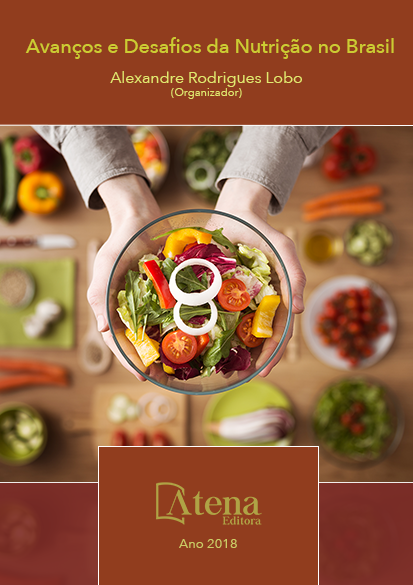
AVALIAÇÃO DA ADEQUAÇÃO DA OFERTA ENERGÉTICO PROTEICA EM PACIENTES INTERNADOS E SUBMETIDOS AO SUPORTE NUTRICIONAL ENTERAL EXCLUSIVO
O suporte nutricional enteral (SNE)
via cateter é utilizado na impossibilidade de
utilização da via oral. Apresenta vantagens
em relação a nutrição parenteral por ser uma
via mais fisiológica, uma vez que mantém a
integridade intestinal da mucosa e objetiva
manter ou reestabelecer o estado nutricional,
minimizar a depleção de massa magra, modular
a resposta imunológica, diminuir o tempo de
internação, morbimortalidade e o risco de
desnutrição. Visa garantir a administração da
oferta adequada de nutrientes de forma contínua.
Sendo assim, faz-se necessário que o prescrito
e o fornecido sejam, de fato, administrados a
fim de evitar prejuízos ao paciente em relação
ao estado nutricional. Objetivou-se verificar se
a oferta energética e proteica da dieta enteral
administrada de forma exclusiva aos pacientes
internados na UTI do Hospital Público do
Município do Estado do Rio de Janeiro. Tratase
de um estudo epidemiológico longitudinal, de
natureza descritiva que foi realizado entre agosto
e dezembro de 2015 com amostra de 81 adultos
acompanhados por no máximo 6 semanas de
internação em uso de SNE exclusivo. O estado
nutricional foi analisado pelo método de triagem
(NRS 2002. Foram coletadas variáveis como
sexo, idade, características da dieta, motivos
da internação, suspensão ou redução da
administração da dieta. A análise dos dados foi
realizada por meio de cálculos de estatísticas
descritivas e aplicação do teste t-student para
amostras pareadas com o intuito de verificar a
adequação da oferta de energia entre valores
prescritos e administrados. Dos 81 pacientes,
45,68% eram mulheres e 54,32% homens, com
média de idade 46,28 ± 12,22 anos. O NRS 2002
revelou 82,7% em risco nutricional e IMC médio
24,40 ± 6,94 kg/m2, que apresentaram como
principal causa de internação e uso de SNE
trauma 24,69%. As causas mais importantes
para suspensão da dieta foram procedimentos
terapêuticos e instabilidade hemodinâmica
19,75%, apesar de 43,21% dos prontuários não
citarem os motivos desta; a média do percentual
de adequação energético proteica foi 59,53% e
58,81%, respectivamente. O principal desfecho
dos pacientes foi a transferência da UTI para
outros setores 51,85%, seguidos por 25,95% de óbitos e 22,22% sem uso de nutrição
enteral exclusiva. Pacientes internados requerem uma maior atenção da equipe
multiprofissional e esta deve estar atenta a vigilância clínica, aos cuidados a serem
prestados e ao manejo nutricional, evitando intercorrências negativas ao tratamento e
auxiliando sua recuperação.
AVALIAÇÃO DA ADEQUAÇÃO DA OFERTA ENERGÉTICO PROTEICA EM PACIENTES INTERNADOS E SUBMETIDOS AO SUPORTE NUTRICIONAL ENTERAL EXCLUSIVO
-
DOI: 10.22533/at.ed.93218021220
-
Palavras-chave: Suporte Nutricional Enteral; NRS 2002; Adequação energético proteica
-
Keywords: Enteral Nutritional Support; NRS 2002; protein energy adequacy.
-
Abstract:
The enteral nutritional support (SNE) is used in the inability to use for oral
feeding. It has advantages over parenteral nutrition because it is a more physiological
pathway, since it keeps the intestinal integrity of the mucosa. An appropriate nutritional
support can maintain or restore the nutritional status, minimize depletion of lean body
mass, modulate the immune response, decrease the length of hospital stay, morbidity
and mortality and the risk of malnutrition. Aims to ensure the administration of adequate
supply of nutrients continuously. Therefore, it is necessary that the prescribed and
supplied are managed to avoid harm to the patient in relation to nutritional status The
objective was to verify if the energy supply and protein administered in the exclusive
enteral nutrition to patients admitted to the ICU of the Public Hospital of State of Rio de
Janeiro attends the prescription service. This is a epidemiological study of a descriptive
nature that took place between August and December 2015 with a sample of 81
adults, followed by up to 6 weeks of hospitalization in use of SNE exclusive. Nutritional
assessment was analyzed by nutritional risk screening method (NRS 2002). Variables
were collected: gender, age, hospitalization reasons, suspension or reduction of diet
administration. Data analysis was performed using descriptive statistics calculations
and test application Student t test for paired samples in order to verify the adequacy of
the supply of energy between prescribed and administered values. Of the 81 patients
evaluated 45.68% were female and 54.32% were males, with a mean age 46.28 ±
12.22 years. The NRS 2002 revealed 82.7% at nutritional risk, which showed the main
cause of hospitalization and use of SNE trauma 24.69%. The most important reasons
for the diet suspension was therapeutic procedures 19.75% hemodynamic instability,
while 43.21% of the records do not mention the reasons for this; The daily provided
was below the prescribed, this difference was statistically significant between them
(p <0.01); the average of energy adequacy and protein percentage was 59.53% and
58.81%, respectively. The main outcome of patients was the transfer from the ICU to
other hospital departments with 51.85%, followed by 25.95% of deaths and 22.22%
without the use of exclusive enteral nutrition. Patients require greater attention of the
multidisciplinary team and this must be careful clinical monitoring, care to be provided
and nutritional management, avoiding negative complications to treatment and helping
recovery.
-
Número de páginas: 15
- Maria Fernanda Larcher de Almeida


